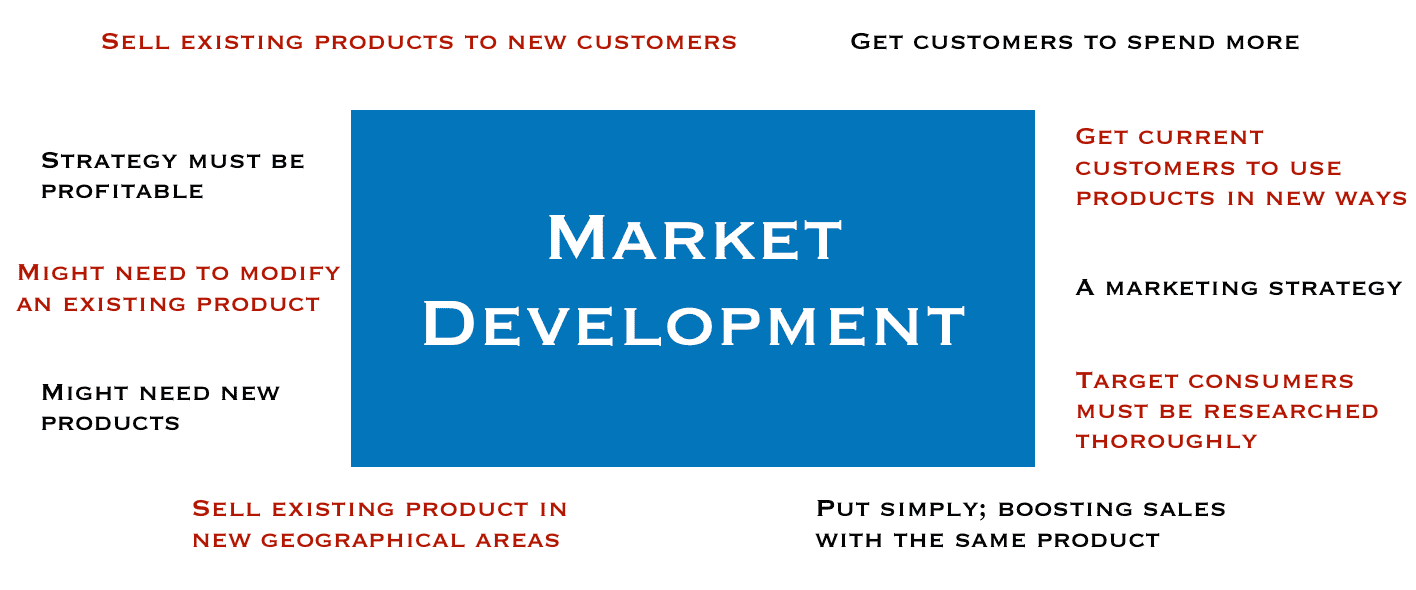Market Development is a marketing strategy in which a company tries to sell an existing product to a new group of consumers.
The seller may do this by promoting the product in a new geographical area. It may also try to present it in different media. For example, if the product currently sells to young people, it may try placing adverts in publications that older consumers read. In other words, it is a strategic step a company takes to exploit an existing market further. It takes this step rather than trying to look for a new market.

To boost sales, the company pitches its product to a new segment of consumers.
Critical to this strategy is assessing the market’s readiness for the product, ensuring alignment with consumer needs and market trends.
Market development also includes trying to get current customers to spend more.
Market development – new users or uses
A market development strategy involves exploiting the market further. Companies can do this by getting new users.
However, they can also boost sales by getting consumers to use their products in new ways, i.e., new uses.
We can define ‘new users’ as:
-
New demographic segments
In other words, selling to different types of consumers. For example, if the company has targeted women, it may now try to target men. Demography is the study of human populations as well as the factors that make them change. Companies that sell cosmetics and skin products have been targeting men for the past two decades. In the past, they would only target female consumers. Leveraging digital platforms allows for precise targeting and analytics, enabling companies to reach and understand these new demographics more effectively.
-
New geographic segments
This means promoting the product in different parts of the country, or even other countries.
-
New psychographic segments
Psychographic segmentation involves dividing a market into different segments based on consumers’ personality traits, values, or interests. It may also involve dividing the market into segments based on people’s lifestyles.
Marketing development – what to consider
Before you implement a market development strategy, you will need to answer the following questions:
- Is the strategy profitable? If so, what is the likely return on investment?
- Will you need to introduce modified products?
- Will you need to introduce new products?
- Have you researched your target consumers extensively enough?
A two-step process
-
Segmentation analysis – research
The company begins by doing a segmentation analysis. It then shortlists market segments that are worth targeting. In this case, it is trying to get new customers interested in an existing product.
The aim is to boost sales by tapping into a new segment or a market the company has not yet exploited.
As soon as it has chosen a segment, the company then creates a promotional strategy. In other words, it finds ways of attracting those consumers.
-
Pricing
The marketing team will also have to price the product competitively, especially if rivals have similar strategies.
Compound nouns
There are many compound nouns (nouns consisting of 2 or more words) containing the term “market development.” Here are seven of them, their meanings, and how we can use them in a sentence:
-
Market Development Strategy
A business plan for marketing existing products to new customer segments.
Example: “Their market development strategy focused on introducing their health drinks to a younger demographic.”
-
Market Development Funds
Financial resources allocated for activities aimed at entering new markets.
Example: “The company allocated significant market development funds for the overseas launch.”
-
Market Development Manager
A professional responsible for identifying and developing new market segments for a product.
Example: “The market development manager orchestrated a campaign to capture the untapped rural market.”
-
Market Development Plan
A detailed blueprint outlining the steps to introduce products to new markets.
Example: “They crafted a comprehensive market development plan to penetrate the European market.”
-
Market Development Team
A group within a company charged with expanding into new market areas.
Example: “Our market development team is researching potential in South American countries.”
-
Market Development Efforts
Collective initiatives taken to expand a product’s market reach.
Example: “The startup’s market development efforts paid off, resulting in a 50% increase in sales.”
-
Market Development Stages
The phases a company goes through when introducing products to new markets.
Example: “The company is currently in the early market development stages in Asia.”
